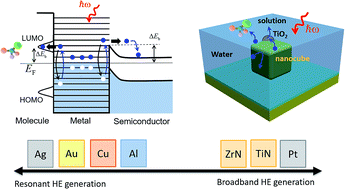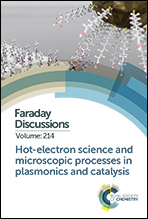Generation of hot electrons in nanostructures incorporating conventional and unconventional plasmonic materials†
Abstract
The generation of energetic electrons is an effect occurring in any plasmonic nanostructure. However, the number of electrons with high energies generated optically in a plasmonic nanostructure can be relatively small. This is an intrinsic property of the collective plasmon excitations in a Fermi gas of electrons. But the choices of material and geometry have a great impact on the generation rate, and are therefore crucial for designing a nanostructure with a large rate of generation of energetic (hot) electrons. Here we test different plasmonic materials from the point of view of the generation of hot electrons (HEs). Our choice of materials includes both strongly-plasmonic materials (Au, Ag, Cu and Al) and crystals with strongly broadened plasmonic resonances (Pt, TiN and ZrN). Regarding the choice of geometry, we consider two types of nanostructures, single nanocrystals deposited over a dielectric substrate and metastructure absorbers, observing interesting opto-electronic properties. For single nanocrystals, the rate of HE generation is strongly material-dependent since the HE generation rate strongly depends on several physical parameters such as plasmonic enhancement, plasmonic resonance wavelength, Fermi energy, etc. Interestingly, the plasmonic meta-absorbers exhibit a different behaviour. The strongly-plasmonic metals, such as Au, Ag, Cu or Al, show very similar performances, while the materials with damped plasmon resonances demonstrate diverse and reduced rates of HE generation. The physical reason for these different behaviours lies in the dielectric functions of these materials. In the metastructures, plasmonic resonances are in the infrared region and the strongly-plasmonic materials behave as an almost ideal metal, whereas the second group of materials exhibits strong dissipation. This makes the responses from the metastructures made of crystals with damped plasmons strongly dependent on the choice of material. The physical principles described in our study can be useful for designing metastructures and nanodevices based on HEs, which can be used in photo-chemistry and opto-electronics.

- This article is part of the themed collection: Hot-electron science and microscopic processes in plasmonics and catalysis

 Please wait while we load your content...
Please wait while we load your content...